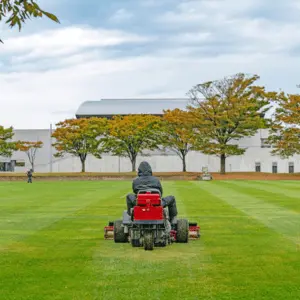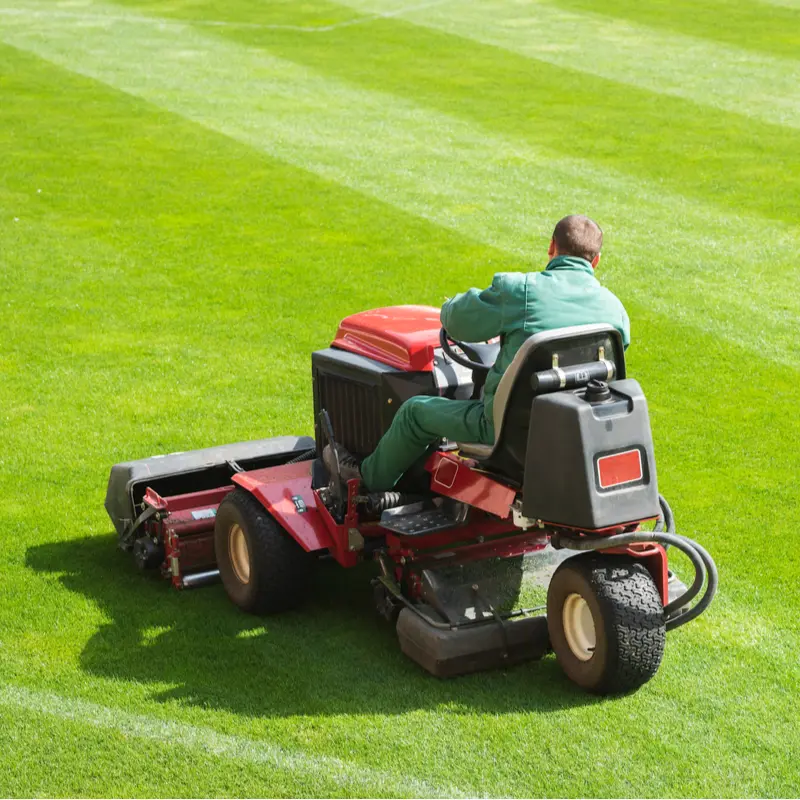Many aspects go into great lawn care, especially for athletic fields, but probably the most important is proper mowing. Delaware Turf specializes in the care and maintenance of athletic fields in the West Chester, Delaware County, and Main Line areas and has compiled a list of information regarding mowing, its benefits, and the best practices for utilizing it.
Why Is Mowing So Important?

Mowing a lawn, any lawn, be it the property around your home, your business, or your athletic field, is essential to your turf’s healthy growth. There are several reasons for this, including:
The Even Growth of Your PA Lawn or Athletic Field
Grass absorbs resources such as water, oxygen, and sunlight. Cutting the growth of it down to a consistent level on a regular basis allows each grass blade to receive equal amounts of all three.
The Improved Health of Your PA Turf
Fallen shoots of grass will help to fertilize the entire field. Some of the extra debris will be returned to the ground for fertilizer. After it decomposes, it will help to revitalize the soil underneath. When grass becomes too long, it becomes more vulnerable to pest infestations and infections of lawn diseases and fungi.
Mowing Improves Your Lawn or Athletic Field’s Overall Appearance
Mowing your turf on a regular basis helps to keep it short, thick, and even. A thick lawn helps to crowd out weeds and give your property the appearance of being well-manicured and orderly.
When to Start Mowing
Whether you are mowing your residential lawn, a business, or are in charge of maintaining an athletic field, you should start mowing as soon as the plant becomes active and the desired height can be achieved. Here in West Chester, Delaware County, and the Main Line, the grass starts growing in April, sometimes as early as March. It just depends on mother nature’s mood and if we get an early or late spring.
Ideal Mowing Height
So what is the ideal mowing height for your Pennslyvania lawn or athletic field? There are different recommendations for mowing height based on your type of grass. A common bunching grass like tall fescue is not suited for shorter cuts and should be mowed between two to three inches in height. For Kentucky bluegrass and ryegrass fields, we suggest mowing height to be around two to two and a half inches. No matter how long you prefer to keep your lawn, you should only remove the top third of the grass blade. Grass that is cut too short can become susceptible to weeds, drought, and heat damage.
Other factors that can determine a proper height include desired field conditions and traffic level. The particular sport played can also determine mowing height. Below, we list the recommended measurements you should mow a field at based on the sport played.
Recommended Mowing Height per Sport
- Multi-use Fields, low budget fields: 2.0 – 3.0”
- Football, Soccer, Lacrosse, Baseball Outfields: 1.5 – 2.5”
- High-Quality Soccer Fields, Field Hockey, Baseball Infields: 1.0 – 2.5”
Mowing Frequency
You should mow your athletic field a minimum of three times per week during the growing season. With our ever-changing weather patterns here in Pennsylvania, there will always be different factors that influence how quickly your grass grows. Some weeks we will have more rain than others and different times of the spring and summer will cause growth rates to vary. Because of this, we recommend that you mow your lawn or athletic field when the grass blades reach one-third higher than the recommended mowing height. For example, if you usually cut your grass two inches in height, mow your turf when it gets to about three inches.
What Is the One-Third Rule for Lawn Mowing?

Never cut more than one-third of the plant height off in one cutting. This is known as the one-third rule. This is called scalping the lawn, and doing this could ruler measuring grassresult in shock and damage to your grass. Worse, the excess clippings from the mowing could smother your grass and add a layer of thatch.
If you get behind on mowing, measure the turf’s height and multiply that number by .667. Lower your mowing height to that number. The following day or two, measure the grass’s height and multiply that number by .666 and then reduce the mowing size to that number. Repeat if necessary until you reach the desired height. Grass that is cut too short is also susceptible to weed invasion, drought, and heat damage.
What Time of Day Should I Mow My Lawn?
Only cut your lawn when it’s dry. Try not to mow after a rainstorm or full-cycle irrigation event. When grass is saturated, it is soft and can easily become compact when lawn equipment is used. During the middle of our Pennsylvania hot summers, try to avoid mowing during the day in the sun, especially if there is no irrigation system available. Try to mow first thing in the morning or evening. Between 11 a.m. and 5 p.m. is the most stressful time for grass because this is when it draws moisture to cool itself.
For All Your PA Lawn and Athletic Field Needs You Want Delaware Valley Turf
Delaware Valley Turf helps schools, townships, universities, and athletic associations with their athletic field maintenance issues in West Chester, Delaware County, and the Main Line areas. We understand that your athletic field needs to be durable, playable, and safe. We provide a variety of athletic field maintenance services, including customized soil fertility programs, weed control, insect control, disease control, aeration and seeding, and topdressing. Call us today at (610) 328-4170 or contact us here online to learn more.
For more ideas, tips, and information regarding all things lawn care and landscaping, check out and follow our blog. Get to know us better by following us on Facebook and Instagram.






Comments (0)
Thanks for your comment!
Thanks for your feedback! Your comments have been successfully submitted! Please note, all comments require admin approval prior to display.
Error submitting comment!
There is a problem with your comment, please see below and try again.